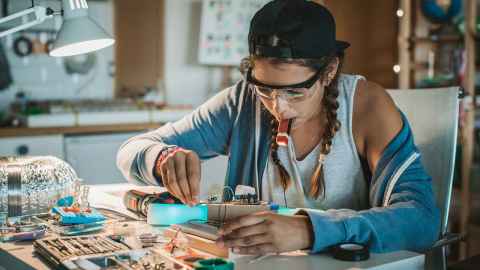The sector with the marked gender imbalance
8 March 2019
Opinion: The theme for International Women’s Day is a more gender-balanced world. We are striving for the same goal in engineering, writes Professor Nic Smith.

This year International Women’s Day encourages us all to create a more gender-balanced world. We can, and should, all play our part.
Engineering has a particularly marked gender imbalance to address: in the vast majority of engineering faculties in the English-speaking world, less than a fifth of students are women. In an age where technology is playing a more important role in our lives than ever before we need people who have talent, perspective, and who can connect to all parts of society. If our engineering faculties, which are the training ground for that talent, aren’t representative of society, then we are all missing out.
At the University of Auckland’s Faculty of Engineering we have set ourselves the immediate goal of increasing first year female undergraduate enrolments to at least 33 percent to address our own gender imbalance. A number of major New Zealand companies have partnered with us to support this goal including Tonkin+Taylor, Mercury and Fisher & Paykel Healthcare.
Our female enrolments this year are around 27 percent. We’d like it to be higher, but if you talk to people in my generation they refer to the one woman in their engineering class. There has been a significant increase of female students in the last five years. We now have a really vibrant, energetic and talented cohort of female students – and we need these numbers to continue to grow.
I’m often asked why more women aren’t attracted to engineering. I would argue there are multiple reasons. When I did engineering there were two stereotypes. There was what I’d call the ‘vitamin D deficient lab rat’ who sat on a computer and didn’t interact much. The other was ‘the philistine driving a bulldozer wearing a hardhat’. But neither were true; they were caricatures, but such stereotyping myths are likely to have been a significant barrier for women.
Another possible part of the problem is that engineering is perceived as hard, as difficult to do. I am generalising, but we have observed that young men tend to have more confidence in their abilities while females often underestimate their talents. But actual ability is completely independent of gender. We run a leadership programme for our top 40 students, based on academic ability, contribution outside the faculty and their potential as future leaders. Last year, 55 percent of those on the programme were female.
There has been a significant increase of female students in the last five years. We now have a really vibrant, energetic and talented cohort of female students – and we need these numbers to continue to grow.
Over the past 30 years we’ve seen a broader view of what engineering is, and developed more understanding of its impact. Specific examples include environmental and biomedical engineering which are relevant to everyone’s lives. These are areas where there is a realisation that technology, when it comes to climate change or health, is part of the solution but also part of the problem. It is the potential of exciting technology combined with the challenge of determining how it can best change people’s lives that seems to be appealing to more women.
As part of our 33 percent goal, we have developed a number of programmes where female students are directly working and engaging with girls at secondary school. The programmes include contributions from successful high profile women in the faculty as well as from a talented cohort of younger female engineers. Every time these women, as students, lecturers or professors, talk to young school students, they are standing up as role models, and opening the eyes of a generation who might not have seen themselves as being able to make a contribution in developing and applying technology.
Working with young female engineers gives school students the opportunity to think, “I can identify with that person, look at the success they’re having, look at the fun they’re having.” This is why we made a decision last year, to get our female students out to schools.
We also had a number of women leaders here who, as part of our summer scholarship programme, invited high school students to engage with engineering, and gain experience of how what they’re learning can be applied in the technology space. This year we’ll be taking these activities out to schools more widely, which connect to the curriculum but also show the possibility of what engineers can do.
We’ve also started a tutoring programme last year, in which our current female students went out and offered high school students who were doing subjects such as maths and physics extra tutoring, to help them get the grades they needed to get in to our faculty. That was very successful. It gave a group of students the chance to connect with the faculty, and the confidence to apply for a Bachelor of Engineering.
Engineering is a diverse topic that requires a diversity of skills. I talk about the four things that students get from studying here. One is technical grounding in a particular area. The other three are creativity, leadership, and the ability to navigate what is going to be an uncertain future. People with these skills are the people that will thrive in the future of work.
Professor Nic Smith is Dean of Engineering. This article reflects the opinion of the author and not the views of the University of Auckland.
Used with permission from Newsroom The sector with the marked gender imbalance published on 8 March 2019.